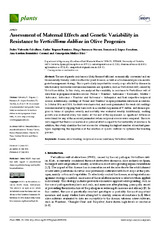Assessment of Maternal Effects and Genetic Variability in Resistance to Verticillium dahliae in Olive Progenies
Autor
Valverde Caballero, Pedro
Trapero Ramírez, Carlos
Barranco Navero, Diego
López Escudero, Francisco Javier
Gordon, Ana
Muñoz Díez, Concepción
Editor
MDPIFecha
2021Materia
DiseaseOlive breeding
Reciprocal crosses
Resistance
Verticillium dahliae
METS:
Mostrar el registro METSPREMIS:
Mostrar el registro PREMISMetadatos
Mostrar el registro completo del ítemResumen
The use of genetic resistance is likely the most efficient, economically convenient and environmentally friendly control method for plant diseases, as well as a fundamental piece in an integrated management strategy. This is particularly important for woody crops affected by diseases in which mainly horizontal resistance mechanisms are operative, such as Verticillium wilt, caused by Verticillium dahliae. In this study, we analyzed the variability in resistance to Verticillium wilt of olive trees in progenies from five crosses: ‘Picual’ × ‘Frantoio’, ‘Arbosana’ × ‘Koroneiki’, ‘Sikitita’ × ‘Arbosana’, ‘Arbosana’ × ‘Frantoio’ and ‘Arbosana’ × ‘Arbequina’ and their respective reciprocal crosses. Additionally, seedlings of ‘Picual’ and ‘Frantoio’ in open pollination were used as controls. In October 2016 and 2018, the fruits were harvested, and seeds germinated. Six-week-old seedlings were inoculated by dipping their bare roots in a conidial suspension of V. dahliae, and disease progress in terms of symptom severity and mortality was evaluated weekly. Additionally, seedling growth was evaluated every two weeks. At the end of the experiment, no significant differences were found for any of the assessed parameters when reciprocal crosses were compared. These results suggest that there is no maternal or paternal effect in regard to the heritability of resistance. In addition, this study identifies the best crosses for obtaining the highest number of resistant genotypes, highlighting the importance of the selection of specific cultivars to optimize the breeding process.

